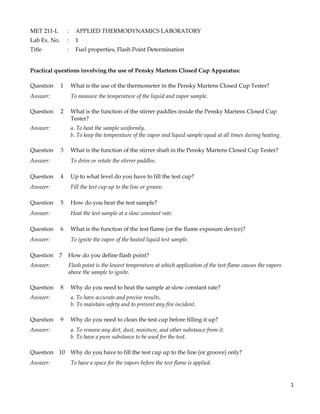
MET211-Lab-Practical questions -_lab_ex._2
- 1. 1 MET 211-L : APPLIED THERMODYNAMICS LABORATORY Lab Ex. No. : 1 Title : Fuel properties, Flash Point Determination Practical questions involving the use of Pensky Martens Closed Cup Apparatus: Question 1 What is the use of the thermometer in the Pensky Martens Closed Cup Tester? Answer: To measure the temperature of the liquid and vapor sample. Question 2 What is the function of the stirrer paddles inside the Pensky Martens Closed Cup Tester? Answer: a. To heat the sample uniformly. b. To keep the temperature of the vapor and liquid sample equal at all times during heating. Question 3 What is the function of the stirrer shaft in the Pensky Martens Closed Cup Tester? Answer: To drive or rotate the stirrer paddles. Question 4 Up to what level do you have to fill the test cup? Answer: Fill the test cup up to the line or groove. Question 5 How do you heat the test sample? Answer: Heat the test sample at a slow constant rate. Question 6 What is the function of the test flame (or the flame exposure device)? Answer: To ignite the vapor of the heated liquid test sample. Question 7 How do you define flash point? Answer: Flash point is the lowest temperature at which application of the test flame causes the vapors above the sample to ignite. Question 8 Why do you need to heat the sample at slow constant rate? Answer: a. To have accurate and precise results. b. To maintain safety and to prevent any fire incident. Question 9 Why do you need to clean the test cup before filling it up? Answer: a. To remove any dirt, dust, moisture, and other substance from it. b. To have a pure substance to be used for the test. Question 10 Why do you have to fill the test cup up to the line (or groove) only? Answer: To have a space for the vapors before the test flame is applied.
- 2. 2 Question 11 Why do you need to close the test cup? Answer: a. To keep the vapor above the sample. b. To prevent the vapor from escaping and mixing with the air outside. Question 12 What is the objective of this laboratory exercise? Answer: To determine the flash point of a certain petroleum sample. Question 13 What is the usefulness of flash point determination in the petrochemical industry? Answer: To determine the transportation and storage temperature requirements for lubricants. Question 14 What is the objective of the laboratory exercise? Answer: To determine the flash point of a certain petroleum product sample. Table of Components: No. Name of Item No. Name of Item 1 Flame exposure device (Test flame) 4 Stirrer paddle for vapor 2 Thermometer 5 Stirrer paddle for liquid 3 Stirrer shaft 6 Test Cup 1 2 4 3 5 6